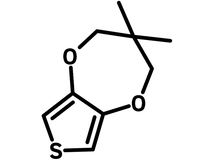3,4-(2,2-Dimethylpropylenedioxy)thiophene
CAS Number 255901-50-9
Chemistry Building Blocks, Heterocyclic Building Blocks, Materials, Monomers3,4-(2,2-Dimethylpropylenedioxy)thiophene
An analog of EDOT, its polymer as cathodic electrochromic material with lower oxidation potentials, and greater stability than polythiophene.
Specifications | MSDS | Literature and Reviews
3,4-(2,2-Dimethylpropylenedioxy)thiophene (ProDOT-Me2, CAS number 255901-50-9), a 3,4-ethylenedioxythiophene (EDOT) analog, has a dimethylpropylene side group instead of ethylene while comparing to the EDOT.
3,4-(2,2-Dimethylpropylenedioxy)thiophene was prepared via trans-etherification by refluxing 3,4-dimethoxythiophene with 2,2-dimethylpropane-1,3-diol in toluene by using p-Toluenesulfonic acid as the catalyst. With lower oxidation potentials, and greater stability than polythiophene, conventional cathodic electrochromic material poly(3,4-propylenedioxythiophene) (PProDOT) exhibits very promising electrochromic performance with more rapid switching. Electrochromic window (ECW) based on PPro-DOT-Me2 shows switching speed for coloring and bleaching were almost 0.7 s in a range of +1.5 V to -1.5 V.
Over 10,000 cycles, with 75.7% as the maximum optical modulation and about 5 s as its response time for both coloring and bleaching processes can be achieved for the device with PProDOT-Me2 as the working electrode, bare indium tin oxide as the counter, and AgNO3, LiBr/Br2 as the electrolyte. Three color states of transparent, blue, and opaque were demonstrated by applying various voltages.
Thiophene derivative building block
for the synthesis of OLED and organic photovoltaic materials
Worldwide shipping
Quick and reliable shipping
Substituted with dimethylpropylene group
for lower oxidation potentials and greater stability
High purity
>97% Purity
General Information
| CAS Number | 255901-50-9 |
| Chemical Formula | C9H12O2S |
| Full Name | 3,4-(2,2-Dimethylpropylenedioxy)thiophene |
| Molecular Weight | 184.26 g/mol |
| Synonyms | 3,4-Dihydro-3,3-dimethyl-2H-thieno[3,4-b-1,4]dioxepine, ProDOT-Me2 |
| Classification / Family | Thiophenes, semiconductor synthesis intermediates, low band gap polymers, OLED, OFETs, organic photovoltaics |
Chemical Structure

Product Details
| Purity | >97% (1H NMR in CDCl3) |
| Melting Point | 45.0 °C |
| Appearance | Pale green/off-white powder/crystals |
MSDS Documentation
3,4-(2,2-Dimethylpropylenedioxy)thiophene MSDS Sheet
Literature and Reviews
- Deterioration mechanism of electrochromic poly(3,4-(2,2-dimethylpropylenedioxy)thiophene) thin films, S. Guan et al., J. Mater. Chem. C, 4, 4584-4591 (2016); DOI: 10.1039/C6TC00930A.
- Flexible electrochromic device based on poly (3,4-(2,2-dimethylpropylenedioxy)thiophene), C. Ma et al., Electrochim. Acta, 54 (2), 598-605 (2008); DOI: 10.1016/j.electacta.2008.07.049.
- A novel photoelectrochromic device based on poly(3,4-(2,2-dimethylpropylenedioxy)thiophene) thin film and dye-sensitized solar cell, S. Yang et al., Sol. Energy Mater. Sol. Cells, 97, 186-190 (2012); DOI: 0.1016/j.solmat.2011.09.038.
